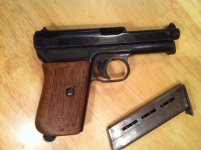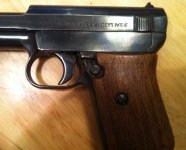Does anyone have any information specific to a Mauser 1914? I have found a few sources of info on the google net but any additional info would be awesome. I currently have in my possession one that was made WW1 era between 1914 and 1923. It is chambered in 7.65 (32 acp) and has the original mag with it. I am looking for any/all info I can get on it (value, production dates, ect.) and this piece is not and will not be for sale.
You are using an out of date browser. It may not display this or other websites correctly.
You should upgrade or use an alternative browser.
You should upgrade or use an alternative browser.
Mauser 1914
- Thread starter dcobler
- Start date
Winchester_73
New member
We need pics of it, including the markings. Little can be said without that. You also did not give the SN, so little can be said except they are fun little guns.
Mine is a rig with a police marking


Mine is a rig with a police marking


In my 2011 Standard Catalog of Firearms it values around 300 in Very Good condition. It is a later model of the run because it does not have the "Mauser" banner on the side plate but it is not stamped "Germany" like on the export models.
SN 187247
It has the crown over the letter u marking behind the rear sight and is marked "L.K. 271" on the right side of the frame above the grip.
Pics to follow
SN 187247
It has the crown over the letter u marking behind the rear sight and is marked "L.K. 271" on the right side of the frame above the grip.
Pics to follow
Also, it was a war bringback by my Great-grandmothers brother
Do you happen to have any bringback paperwork to go with the gun? Having the bringback papers would definitely increase the value of the piece.
According to Mauser Pocket Pistols 1910-1946, by the late Roy G. Pender, your gun falls neatly into the "early postwar commercial" block. He documented serial #186703 given as shooting prize in 1919, and, since your s/n is higher, it is most likely going to be an early post WWI gun. Your gun has the heavy one line address on the slide, which ws later replaced around the end of the series by a two line address.
The "L.K." probably indicates police issue during the Weimar Republic period, especially since the mag is numbered to the gun which, as far as I know, was not done at the Mauser factory. (Someone else may chime on on what "L.K." means; I'm not up on German issue markings.)
Anyway, unless your great grandmother's brother served in WWII, it is unlikely that it was a bringback.
One note of caution about Mauser 1910 and 1914 pistols: Inserting the magazine is the correct way to allow the slide to go forward. Some users attempt to pull the slide back and release it rapidly without the mag inserted. This results in wear on the internals, making the pistol potentially dangerous. Also, be aware that when a fully loaded mag is inserted, it will automatically chamber the first round; Make sure the pistol is pointed in a safe direction when chambering a round as these designs become prone to ADs when worn.
The "L.K." probably indicates police issue during the Weimar Republic period, especially since the mag is numbered to the gun which, as far as I know, was not done at the Mauser factory. (Someone else may chime on on what "L.K." means; I'm not up on German issue markings.)
Anyway, unless your great grandmother's brother served in WWII, it is unlikely that it was a bringback.
One note of caution about Mauser 1910 and 1914 pistols: Inserting the magazine is the correct way to allow the slide to go forward. Some users attempt to pull the slide back and release it rapidly without the mag inserted. This results in wear on the internals, making the pistol potentially dangerous. Also, be aware that when a fully loaded mag is inserted, it will automatically chamber the first round; Make sure the pistol is pointed in a safe direction when chambering a round as these designs become prone to ADs when worn.
Yes, as I wasnt specific earlier, it was brought back from WWII.gyvel said:Anyway, unless your great grandmother's brother served in WWII, it is unlikely that it was a bringback.
I havent tried loading it yet for this reason. Maybe I will make it to the range in the next few days.gyvel said:Make sure the pistol is pointed in a safe direction when chambering a round as these designs become prone to ADs when worn.
I havent tried loading it yet for this reason. Maybe I will make it to the range in the next few days.
It is a little disconcerting to insert a loaded magazine into a gun and have it automatically chamber a round. I have never personally had an AD with a Mauser, but I did have one with a Webley & Scott .38 automatic, which had a similar system. It was a test fire on an unproven gun, so I had it pointed straight at the bullet trap.
Your Mauser looks to be in very nice condition, so I doubt that you will have any problems, but better safe than sorry.
Winchester_73
New member
So does anyone have any more info as to the "L.K. 271" marking?
http://luger.gunboards.com/showthread.php?17929-Mauser-1914-humpback
Also, that site, the Jan Still forum is a great place to learn about pre WWI, WWI and WWII pistols.
Thanks for the link. They were able to identify the marking.
http://luger.gunboards.com/showthread.php?31754-Help-with-a-Mauser-1914&highlight=mauser+1914
http://luger.gunboards.com/showthread.php?31754-Help-with-a-Mauser-1914&highlight=mauser+1914
Don Maus said:Landjäger-Korps (rural police) of Württemberg (HWIS pp. 253-4).
That explains the "L.K. 271"
James K said:FWIW, that pistol has been reblued and the grips sanded
What gives that away? From what I can tell it appears to have similar wear to other pistols I have seen from the era but I am by NO means an expert.
Winchester_73
New member
What gives that away? From what I can tell it appears to have similar wear to other pistols I have seen from the era but I am by NO means an expert.
Compare your grips to mine. See the checkering on mine?
Sometimes you gotta play Sherlock Holmes / Columbo etc with this stuff. The gun has most of its finish, but the checkering of the grips is completely gone on both sides? Something is fishy there. It would take a heck of a lot of use to naturally wear the checkering like that, and being that they don't bear any other wear, the grips being sanded down is very likely.
As far as the refinish of the metal, I don't see any obvious signs of that but ol Jimmy K has a good eye for this stuff.
carguychris
New member
The outline of the previous checkering is still visible on the grip panels.What gives that away? From what I can tell it appears to have similar wear to other pistols I have seen from the era but I am by NO means an expert.
Although I'm no expert either, IIRC every original Mauser pocket pistol I've examined had a straw-colored trigger and bluing with a dark brownish grey color rather than a plum or deep black color. Although Win73's pistol is missing much of its finish, it illustrates these characteristics.
Winchester_73
New member
Although Win73's pistol is missing much of its finish, it illustrates these characteristics.
Hey now! Actually its a bad pic. Some of the "wear" is a light reflection, and there is some thinning of the bluing with a little patina too. The gun is pretty nice IMO for being a police pistol.
Those pistols were originally rust blued, and the finish I see is hot caustic blue, which did not come into use until around 1936. In addition, Mauser simply did not polish those guns that well. Few factories did, as it was too costly in terms of time. Also the surfaces show rounding at the edges and at the joint between the frame and the sideplate. No, the rounding is not a light trick; it is there.
FWIW, here is a refinish spotting "tip of the week". It isn't always true, but it is a good bet that when a sideplate of a quality gun is involved, the factory polished the plate and the frame together, leaving a very close fit and often a nearly invisible seam. But rebluers normally take the plate off and polish it and the frame separately, leaving the edges of both rounded so there is a "dip" at the joint and sometimes a gap.
Jim
FWIW, here is a refinish spotting "tip of the week". It isn't always true, but it is a good bet that when a sideplate of a quality gun is involved, the factory polished the plate and the frame together, leaving a very close fit and often a nearly invisible seam. But rebluers normally take the plate off and polish it and the frame separately, leaving the edges of both rounded so there is a "dip" at the joint and sometimes a gap.
Jim


